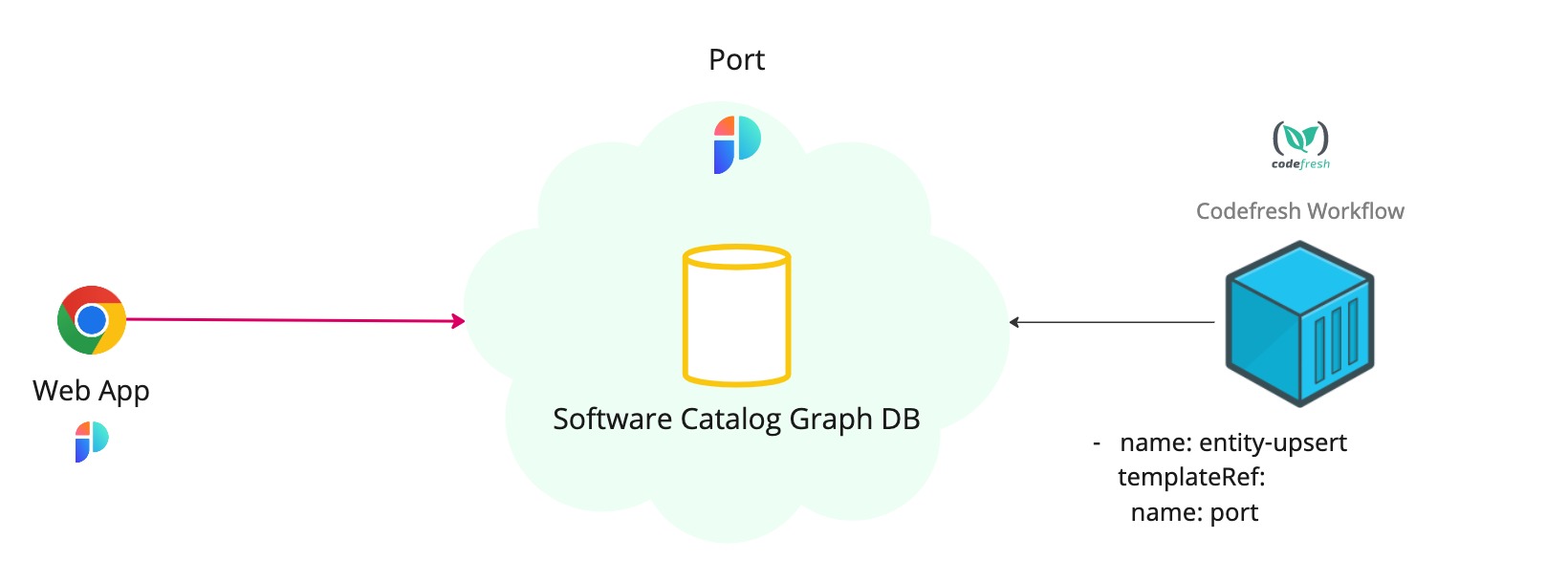Codefresh Workflow Template
Our Codefresh workflow template allows you to create/update and query entities in Port directly from your Codefresh workflow templates.

💡 Codefresh integration usage
Port's Codefresh workflow template provides a native way to integrate Port with your Codefresh CI workflows, for example:
- Report the status of a running CI job;
- Update the software catalog about a new build version for a microservice;
- Get existing entities.
Installation
To use Port's Codefresh workflow template you need to perform the following steps:
- Go to the workflow template repository in GitHub;
- Copy the file
portWorkflowTemplate.ymlto one of your codefreshgit sourcesand commit it to your git source; - Add the required service account, cluster role and role binding to your codefresh runtime namespace by applying the contents of the
rbac.ymlfile by using the command:kubectl apply -f rbac.yml -n YOUR_NAMESPACE; - Add the required secret containing your
PORT_CLIENT_IDandPORT_CLIENT_SECRETafter encoding them using base64. You can useportCredentials.ymlas an example.
If you save the CLIENT_ID and SECRET using the exact format shown in portCredentials.yml, you do not need to provide the parameters PORT_CREDENTIALS_SECRET, PORT_CLIENT_ID_KEY and PORT_CLIENT_SECRET_KEY when calling templates from the workflow template.
Verify
To verify the installation of the workflow template, follow these steps:
- Go to the Codefresh interface;
- Under the CI OPS category, click on Workflow Templates;
- In the search bar, type
portthe workflow template should appear.
Usage
Port's Codefresh workflow template supports the following methods:
- Create/Update catalog entities - invoked with the
upsert-entitytemplate, receives the identifier and other properties of a new entity or an entity that needs to be updated; - Get catalog entities - invoked with the
get-entitytemplate, receives the identifier of an existing entity and retrieves it for use in your CI.
- Create/Update
- Get
- name: entity-upsert
templateRef:
name: port
template: entity-upsert
arguments:
parameters:
# Note: if you save the CLIENT_ID and CLIENT_SECRET in the same format shown
# in the portCredentials.yml file, there is no need to provide
# PORT_CREDENTIALS_SECRET, PORT_CLIENT_ID_KEY, PORT_CLIENT_SECRET_KEY
- name: PORT_CREDENTIALS_SECRET
value: "port-credentials"
- name: PORT_CLIENT_ID_KEY
value: "PORT_CLIENT_ID"
- name: PORT_CLIENT_SECRET_KEY
value: "PORT_CLIENT_SECRET"
- name: BLUEPRINT_IDENTIFIER
value: "myBlueprint"
- name: ENTITY_IDENTIFIER
value: "myEntity"
- name: ENTITY_TITLE
value: "myTitle"
- name: ENTITY_PROPERTIES
value: |
{
"myStringProp": "My value",
"myNumberProp": 1,
"myBooleanProp": true,
"myArrayProp": ["myVal1", "myVal2"],
"myObjectProp": {"myKey": "myVal", "myExtraKey": "myExtraVal"}
}
Inputs
| Input | Description | Notes |
|---|---|---|
PORT_CREDENTIALS_SECRET | Name of the secret to get the CLIENT_ID and CLIENT_SECRET from | Default value: port-credentials |
PORT_CLIENT_ID_KEY | Key in the secret where the base64 encoded PORT_CLIENT_ID is stored | Default value: PORT_CLIENT_ID |
PORT_CLIENT_SECRET_KEY | key in the secret where the base64 encoded PORT_CLIENT_SECRET is stored | Default value: PORT_CLIENT_SECRET |
BLUEPRINT_IDENTIFIER | Identifier of the blueprint to create an entity of | Required |
ENTITY_IDENTIFIER | Identifier of the new (or existing) entity | Leave empty to get an auto-generated identifier |
ENTITY_TITLE | Title of the new (or existing) entity | |
ENTITY_TEAM | Teams array of the new (or existing) entity | |
ENTITY_ICON | Icon of the new (or existing) entity | |
ENTITY_PROPERTIES | Properties of the new (or existing) entity | |
ENTITY_RELATIONS | Relations of the new (or existing) entity. |
Outputs
| Output | Description | Notes |
|---|---|---|
ENTITY_IDENTIFIER | identifier of the new (or existing) entity |
- name: entity-get
templateRef:
name: port
template: entity-get
arguments:
parameters:
# Note: if you save the CLIENT_ID and CLIENT_SECRET in the same format shown
# in the portCredentials.yml file, there is no need to provide
# PORT_CREDENTIALS_SECRET, PORT_CLIENT_ID_KEY, PORT_CLIENT_SECRET_KEY
- name: PORT_CREDENTIALS_SECRET
value: "port-credentials"
- name: PORT_CLIENT_ID_KEY
value: "PORT_CLIENT_ID"
- name: PORT_CLIENT_SECRET_KEY
value: "PORT_CLIENT_SECRET"
- name: BLUEPRINT_IDENTIFIER
value: "microservice"
- name: ENTITY_IDENTIFIER
value: "morp"
Inputs
| Input | Description | Notes |
|---|---|---|
PORT_CREDENTIALS_SECRET | Name of the secret to get the CLIENT_ID and CLIENT_SECRET from | Default value: port-credentials |
PORT_CLIENT_ID_KEY | Key in the secret where the base64 encoded PORT_CLIENT_ID is stored | Default value: PORT_CLIENT_ID |
PORT_CLIENT_SECRET_KEY | Key in the secret where the base64 encoded PORT_CLIENT_SECRET is stored | Default value: PORT_CLIENT_SECRET |
BLUEPRINT_IDENTIFIER | Identifier of the blueprint the target entity is from | Required |
ENTITY_IDENTIFIER | Identifier of the target entity |
Outputs
| Output | Description | Notes |
|---|---|---|
PORT_COMPLETE_ENTITY | Complete entity JSON | |
PORT_BLUEPRINT_IDENTIFIER | Identifier of the blueprint the target entity is from | |
PORT_ENTITY_IDENTIFIER | Identifier of the target entity | |
PORT_ENTITY_TITLE | Title of the entity | |
PORT_ENTITY_PROPERTIES | All properties of the entity in JSON format | |
PORT_ENTITY_RELATIONS | All relations of the entity in JSON format |
Examples
Refer to the examples page for practical examples of Port's Codefresh workflow template.